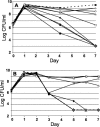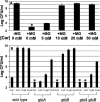Antiglycation effects of carnosine and other compounds on the long-term survival of Escherichia coli
- PMID: 20952637
- PMCID: PMC3008226
- DOI: 10.1128/AEM.01369-10
Antiglycation effects of carnosine and other compounds on the long-term survival of Escherichia coli
Abstract
Glycation, or nonenzymatic glycosylation, is a chemical reaction between reactive carbonyl-containing compounds and biomolecules containing free amino groups. Carbonyl-containing compounds include reducing sugars such as glucose or fructose, carbohydrate-derived compounds such as methylglyoxal and glyoxal, and nonsugars such as polyunsaturated fatty acids. The latter group includes molecules such as proteins, DNA, and amino lipids. Glycation-induced damage to these biomolecules has been shown to be a contributing factor in human disorders such as Alzheimer's disease, atherosclerosis, and cataracts and in diabetic complications. Glycation also affects Escherichia coli under standard laboratory conditions, leading to a decline in bacterial population density and long-term survival. Here we have shown that as E. coli aged in batch culture, the amount of carboxymethyl lysine, an advanced glycation end product, accumulated over time and that this accumulation was affected by the addition of glucose to the culture medium. The addition of excess glucose or methylglyoxal to the culture medium resulted in a dose-dependent loss of cell viability. We have also demonstrated that glyoxylase enzyme GloA plays a role in cell survival during glycation stress. In addition, we have provided evidence that carnosine, folic acid, and aminoguanidine inhibit glycation in prokaryotes. These agents may also prove to be beneficial to eukaryotes since the chemical processes of glycation are similar in these two domains of life.
Figures






Similar articles
-
Rich Medium Composition Affects Escherichia coli Survival, Glycation, and Mutation Frequency during Long-Term Batch Culture.Appl Environ Microbiol. 2015 Jul;81(13):4442-50. doi: 10.1128/AEM.00722-15. Epub 2015 Apr 24. Appl Environ Microbiol. 2015. PMID: 25911475 Free PMC article.
-
Novel Facial Cream Containing Carnosine Inhibits Formation of Advanced Glycation End-Products in Human Skin.Skin Pharmacol Physiol. 2018;31(6):324-331. doi: 10.1159/000492276. Epub 2018 Sep 10. Skin Pharmacol Physiol. 2018. PMID: 30199874 Free PMC article.
-
Protein Glycation in Plants-An Under-Researched Field with Much Still to Discover.Int J Mol Sci. 2020 May 30;21(11):3942. doi: 10.3390/ijms21113942. Int J Mol Sci. 2020. PMID: 32486308 Free PMC article. Review.
-
The Role of Glyoxalase in Glycation and Carbonyl Stress Induced Metabolic Disorders.Curr Protein Pept Sci. 2020;21(9):846-859. doi: 10.2174/1389203721666200505101734. Curr Protein Pept Sci. 2020. PMID: 32368974 Review.
-
State of the art clinical efficacy and safety evaluation of N-acetylcarnosine dipeptide ophthalmic prodrug. Principles for the delivery, self-bioactivation, molecular targets and interaction with a highly evolved histidyl-hydrazide structure in the treatment and therapeutic management of a group of sight-threatening eye diseases.Curr Clin Pharmacol. 2009 Jan;4(1):4-37. doi: 10.2174/157488409787236074. Curr Clin Pharmacol. 2009. PMID: 19149498 Clinical Trial.
Cited by
-
Absence of Ribosome Modulation Factor Alters Growth and Competitive Fitness of Escherichia coli.Microbiol Spectr. 2022 Apr 27;10(2):e0223921. doi: 10.1128/spectrum.02239-21. Epub 2022 Apr 4. Microbiol Spectr. 2022. PMID: 35377189 Free PMC article.
-
Revisiting amino acids and peptides as anti-glycation agents.Medchemcomm. 2018 Feb 12;9(4):614-624. doi: 10.1039/c7md00514h. eCollection 2018 Apr 1. Medchemcomm. 2018. PMID: 30108952 Free PMC article. Review.
-
Synthesis and evaluation of L-arabinose-based cationic glycolipids as effective vectors for pDNA and siRNA in vitro.PLoS One. 2017 Jul 3;12(7):e0180276. doi: 10.1371/journal.pone.0180276. eCollection 2017. PLoS One. 2017. PMID: 28672000 Free PMC article.
-
The Anti-Cancer Activity of the Naturally Occurring Dipeptide Carnosine: Potential for Breast Cancer.Cells. 2023 Nov 8;12(22):2592. doi: 10.3390/cells12222592. Cells. 2023. PMID: 37998326 Free PMC article. Review.
-
Motor Unit Fatigability following Chronic Carnosine Supplementation in Aged Rats.Nutrients. 2022 Jan 25;14(3):514. doi: 10.3390/nu14030514. Nutrients. 2022. PMID: 35276873 Free PMC article.
References
-
- Ahmed, M. U., S. R. Thorpe, and J. W. Baynes. 1986. Identification of N-epsilon-carboxymethyllysine as a degradation product of fructoselysine in glycated proteins. J. Biol. Chem. 261:4889-4894. - PubMed
-
- Aldini, G., M. Carini, G. Beretta, S. Bradamante, and R. M. Facino. 2002. Carnosine is a quencher of 4-hydroxy-nonenal, through what mechanism of reaction? Biochem. Biophys. Res. Commun. 298:699-706. - PubMed
-
- Booth, A. A., R. G. Khalifah, P. Todd, and B. G. Hudson. 1997. In vitro kinetic studies of formation of antigenic advanced glycation end products (AGEs), novel inhibition of post-Amadori glycation pathways. J. Biol. Chem. 272:5430-5437. - PubMed
-
- Branda, R. F., Z. Chen, E. M. Brooks, S. J. Naud, T. D. Trainer, and J. J. McCormack. 2002. Diet modulates the toxicity of cancer chemotherapy in rats. J. Lab. Clin. Med. 140:358-368. - PubMed
Publication types
MeSH terms
Substances
LinkOut - more resources
Full Text Sources
Other Literature Sources
Molecular Biology Databases

